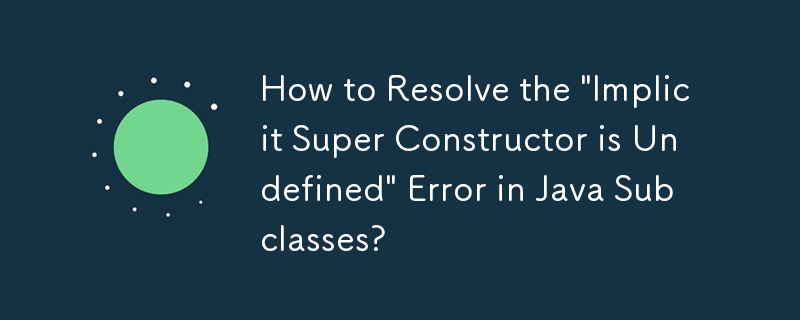 Java
Java
 javaTutorial
javaTutorial
 How to Resolve the \'Implicit Super Constructor is Undefined\' Error in Java Subclasses?
How to Resolve the \'Implicit Super Constructor is Undefined\' Error in Java Subclasses?
How to Resolve the \'Implicit Super Constructor is Undefined\' Error in Java Subclasses?

Removing Redundant Constructors in Subclasses with Default Constructor
When working with inheritance in Java, it's common to encounter the "Implicit super constructor is undefined for default constructor" error. This occurs when a subclass doesn't explicitly define a constructor but extends a base class with a parameterized constructor.
To understand this error, it's important to clarify the behavior of constructors in Java:
- Default Constructors: Classes without explicitly declared constructors have a default, no-argument constructor provided by the compiler.
- Inherited Constructors: If a subclass doesn't declare a constructor, it inherits any available constructors from its parent class.
In your example, the BaseClass has a parameterized constructor but no default constructor. This means that the ACSubClass doesn't have a default constructor and must explicitly define one.
However, because the BaseClass has a parameterized constructor, it doesn't implicitly have a default constructor. This results in the error because ACSubClass can't inherit a non-existent constructor from BaseClass.
There are two ways to address this:
-
Provide a No-Argument Constructor in BaseClass:
Add a default constructor to BaseClass that initializes the someString field to a default value or null. This ensures that all subclasses can inherit a no-argument constructor to satisfy the super constructor call. -
Explicitly Define the Subclass Constructor:
Instead of relying on constructor inheritance, explicitly define a constructor in each subclass that calls the super constructor and passes the required arguments. This approach avoids potential issues related to constructor inheritance and ensures that the base class constructor is always invoked.
The above is the detailed content of How to Resolve the \'Implicit Super Constructor is Undefined\' Error in Java Subclasses?. For more information, please follow other related articles on the PHP Chinese website!

Hot AI Tools

Undresser.AI Undress
AI-powered app for creating realistic nude photos

AI Clothes Remover
Online AI tool for removing clothes from photos.

Undress AI Tool
Undress images for free

Clothoff.io
AI clothes remover

AI Hentai Generator
Generate AI Hentai for free.

Hot Article

Hot Tools

Notepad++7.3.1
Easy-to-use and free code editor

SublimeText3 Chinese version
Chinese version, very easy to use

Zend Studio 13.0.1
Powerful PHP integrated development environment

Dreamweaver CS6
Visual web development tools

SublimeText3 Mac version
God-level code editing software (SublimeText3)

Hot Topics
 1359
1359
 52
52
 How do I implement multi-level caching in Java applications using libraries like Caffeine or Guava Cache?
Mar 17, 2025 pm 05:44 PM
How do I implement multi-level caching in Java applications using libraries like Caffeine or Guava Cache?
Mar 17, 2025 pm 05:44 PM
The article discusses implementing multi-level caching in Java using Caffeine and Guava Cache to enhance application performance. It covers setup, integration, and performance benefits, along with configuration and eviction policy management best pra
 How can I implement functional programming techniques in Java?
Mar 11, 2025 pm 05:51 PM
How can I implement functional programming techniques in Java?
Mar 11, 2025 pm 05:51 PM
This article explores integrating functional programming into Java using lambda expressions, Streams API, method references, and Optional. It highlights benefits like improved code readability and maintainability through conciseness and immutability
 How does Java's classloading mechanism work, including different classloaders and their delegation models?
Mar 17, 2025 pm 05:35 PM
How does Java's classloading mechanism work, including different classloaders and their delegation models?
Mar 17, 2025 pm 05:35 PM
Java's classloading involves loading, linking, and initializing classes using a hierarchical system with Bootstrap, Extension, and Application classloaders. The parent delegation model ensures core classes are loaded first, affecting custom class loa
 How can I use JPA (Java Persistence API) for object-relational mapping with advanced features like caching and lazy loading?
Mar 17, 2025 pm 05:43 PM
How can I use JPA (Java Persistence API) for object-relational mapping with advanced features like caching and lazy loading?
Mar 17, 2025 pm 05:43 PM
The article discusses using JPA for object-relational mapping with advanced features like caching and lazy loading. It covers setup, entity mapping, and best practices for optimizing performance while highlighting potential pitfalls.[159 characters]
 How do I use Maven or Gradle for advanced Java project management, build automation, and dependency resolution?
Mar 17, 2025 pm 05:46 PM
How do I use Maven or Gradle for advanced Java project management, build automation, and dependency resolution?
Mar 17, 2025 pm 05:46 PM
The article discusses using Maven and Gradle for Java project management, build automation, and dependency resolution, comparing their approaches and optimization strategies.
 How do I use Java's NIO (New Input/Output) API for non-blocking I/O?
Mar 11, 2025 pm 05:51 PM
How do I use Java's NIO (New Input/Output) API for non-blocking I/O?
Mar 11, 2025 pm 05:51 PM
This article explains Java's NIO API for non-blocking I/O, using Selectors and Channels to handle multiple connections efficiently with a single thread. It details the process, benefits (scalability, performance), and potential pitfalls (complexity,
 How do I create and use custom Java libraries (JAR files) with proper versioning and dependency management?
Mar 17, 2025 pm 05:45 PM
How do I create and use custom Java libraries (JAR files) with proper versioning and dependency management?
Mar 17, 2025 pm 05:45 PM
The article discusses creating and using custom Java libraries (JAR files) with proper versioning and dependency management, using tools like Maven and Gradle.
 How do I use Java's sockets API for network communication?
Mar 11, 2025 pm 05:53 PM
How do I use Java's sockets API for network communication?
Mar 11, 2025 pm 05:53 PM
This article details Java's socket API for network communication, covering client-server setup, data handling, and crucial considerations like resource management, error handling, and security. It also explores performance optimization techniques, i



